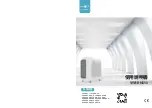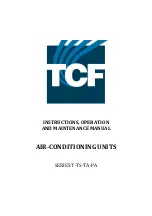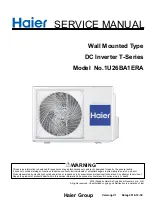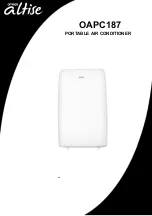
LCP
RG66006889-Rev.01
8
The possible operations are:
Summer Mode:
a)
Cooling Only (represented on following page):
the system produces cold water on
circuit "1" with the heat exchanger "S1" and the heat removed, together with the
power absorbed by the compressors, is dispersed into the outdoor air by means of
finned coils (S3) which act as condensers. Ventilation is modulated to vary the air
flow depending on condensation pressure.
b)
C DHW (represented on following page):
the system produces cold water
on circuit "1" with the heat exchanger "S1" and hot water on circuit "2" with the heat
exchanger "S2". The heat removed by the heat exchanger "S1", together with the
power absorbed by the compressors, is yielded to the hot water by means of the
plate heat exchanger "S2". Both circuits have the same priority, namely both will be
brought to the set-point. The finned pack heat exchangers are used to dispose
of/remove heat from the air only when requests are not equivalent. Ventilation is
normally disabled in this mode. If the finned pack heat exchanger (S3) is used,
ventilation is modulated in order to vary air flow autonomously from the two circuits
depending on the condensation/evaporation pressure.
c)
DHW Only (represented on following page):
the system produces hot water on
circuit "2", removing heat from outdoor air which, together with the power absorbed
by the compressors, is yielded to the water by means of the plate heat exchanger
(S2). Ventilation is modulated to vary the air flow depending on evaporation pressure.
Winter Mode:
d)
Heat Only (represented on following page):
the system produces hot water on
circuit "1", removing heat from outdoor air which, together with the power absorbed
by the compressors, is yielded to the water by means of the plate heat exchanger
“S1”. Ventilation is modulated to vary the air flow depending on evaporation pressure.
e)
DHW Only (represented on following page):
the system produces hot water on
circuit "2", removing heat from outdoor air which, together with the power absorbed
by the compressors, is yielded to the water by means of the plate heat exchanger
(S2). Ventilation is modulated to vary the air flow depending on evaporation pressure.
f)
Partial heat + partial DHW:
the system simultaneously produces hot water on circuit
"1" and on circuit "2" up to a maximum of 50% of both demands. If one of the two
demands exceeds 50%, priority is given to DHW, therefore to circuit "2". The heat is
removed from the outdoor air which, together with the power absorbed by the
compressors, is yielded to the utility by means of the heat exchanger "S1" and to the
DHW by means of the plate hat exchanger "S2".
Defrost cycle:
the purpose is to produce heat which first heats and then melts the frost built up on the
finned coils. In order to do this, the hot water is used as a source and therefore the heat exchanger "S1"
or "S2" is used as an evaporator. The heat removed, together with the power absorbed by the
compressors, is used to defrost the finned pack exchangers (S3). Defrost logic has a low impact on the
utility since defrosting is performed separately on the 2 circuits. In this way while one circuit defrosts, the
other continues to produce heat for the utility, thus avoiding to remove heat from the system.









































